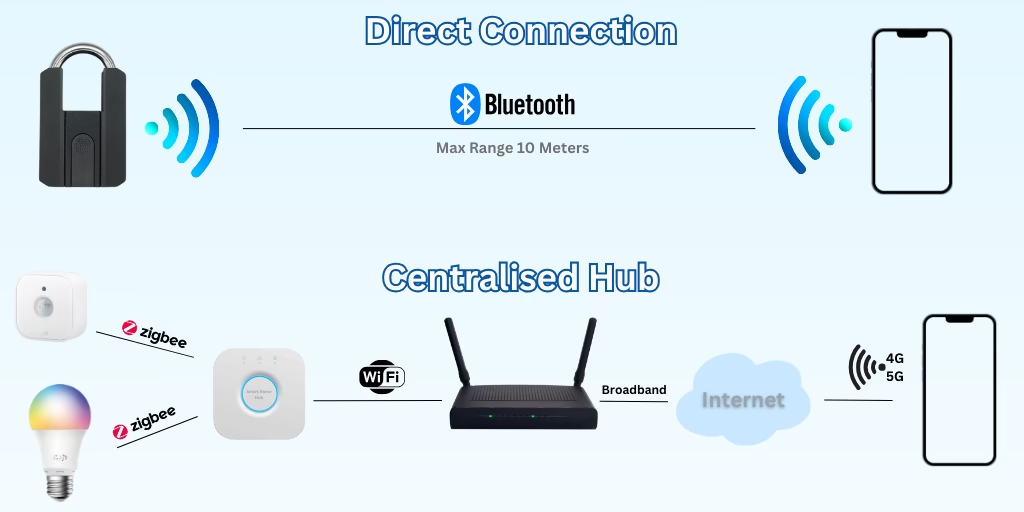Direct Vs Hub Based Smart Home Connectivity
Whether it’s controlling lights, adjusting thermostats, or monitoring security, smart devices rely on various wireless protocols to communicate. In setting up your smart home, one of the decisions is whether to use devices that connect directly to your network (or to each other) or to deploy a hub that ties everything together centrally. In this article, we’ll explore these connectivity approaches, review some common wireless protocols, and discuss the advantages and disadvantages of each, with examples to illustrate their real world use.
Direct Connectivity
How It Works
Direct connectivity means that a smart device communicates directly with your home WiFi network or a smartphone without an intermediary device, (like a smart hub or Alexa) and not going over the internet (aka local smart home). Typically, these types of direct connect smart devices use Wi‑Fi or Bluetooth to send and receive data.
Examples
- Wi‑Fi Devices: Some smart plugs, water timers, light bulbs connect straight to your Wi‑Fi network and are controlled via an app on your smartphone over you local WiFi network.
Be aware that there are many WiFi smart devices that actually connect over the internet to a cloud server and when you use an app to control them, even if you’re at home on the same WiFi network. The app connects to the cloud server to control the smart device, this is not a direct connection. - Bluetooth Devices: Some garden irrigation and smart locks rely on Bluetooth for pairing with a smartphone or tablet. These work well for short-range, point‑to‑point communication.
Pros of Direct Connectivity
- Simplicity: Fewer components mean a less complex installation process. There is no separate hub to purchase, configure, or maintain.
- Cost‑Effective: Without the need for an extra device, initial equipment costs are often lower.
- Low Latency: Direct connections can sometimes offer faster response times since data doesn’t need to be relayed through an intermediary device.
Cons of Direct Connectivity
- Network Load: Adding multiple Wi‑Fi devices can congest your home network, which might affect performance across all connected devices. Although, this is very unlikely as most smart devices require very little data. Devices like WiFi smart cameras use a lot more data..
- Limited Range: While Wi‑Fi and Bluetooth are excellent for many applications, their effective range may be inadequate for larger homes or outdoor areas without additional repeaters.
Hub-Based Connectivity: The Centralised Approach
How It Works
Hub based systems require a central device, often called a bridge, gateway, or hub that manages communication among devices. Wireless smart devices that use Zigbee, Z‑Wave, or Thread are commonly used in these systems because they are designed as a low power, mesh network that operates independently of your home’s Wi‑Fi.
Examples
- Philips Hue Lighting: Philips Hue smart bulbs use Zigbee to communicate with the Philips Hue Bridge. The bridge then connects to your home network, allowing internet access and for you to control lighting via an app or voice assistant.
- Smart Security Systems: Many smart security sensors, such as door/window sensors and motion detectors, use wireless technology that requires a central smart hub.
- Advanced Home Automation: Some systems combine multiple protocols. For example, the Apple HomeKit ecosystem utilises hubs such as the Apple TV or HomePod to manage accessories that might not all share the same wireless protocol.
Pros of Hub-Based Connectivity
- Enhanced Integration: A central hub can bridge different wireless protocols and allow devices that wouldn’t normally “talk” to each other to work together.
- Network Offloading: Devices using Zigbee or Z‑Wave aren’t burdening your Wi‑Fi network, which can lead to a more reliable overall network.
- Improved Range and Scalability: Many hub based systems create mesh networks where each device relays information. This significantly extends the communication range and ensures better coverage over large areas.
- Battery Life: Protocols like Zigbee and Z‑Wave are designed for low power consumption, often resulting in longer battery life for sensors and other battery operated devices.
Cons of Hub Based Connectivity
- Additional Cost: Purchasing a hub can add to your initial investment, which might be a disadvantage for smaller setups.
- Setup Complexity: New users might face a slight learning curve when setting up routines or connecting devices.
- Single Point of Failure: In a hub based system, if the hub malfunctions or loses its connection, devices will become inaccessible until the issue is resolved.
Making the Right Choice for Your Home
Considerations for Direct Connectivity
- Size and Layout: For smaller apartments or houses with a strong, central Wi‑Fi network, directly connected devices might suffice.
- Simplicity and Budget Friendly: If you’re just starting out or prefer a less complex system, choosing devices that connect directly can be a practical solution.
- Immediate Control: Avoiding a hub means less time spent configuring an extra device and immediate direct control over each smart device.
Considerations for Hub‑Based Systems
- Large Homes: In larger environments, the mesh networking provided by Zigbee or Z‑Wave can offer superior coverage.
- Device Integration: If you plan to expand your smart home system with a variety of devices from different manufacturers, a hub can serve as the central “translator” among them.
- Power Efficiency: For sensor arrays and devices that need to run off batteries for extended periods, the low power consumption of a hub based protocols is a significant advantage.
Conclusion
Choosing between direct connectivity and hub‑based systems comes down to your specific needs, budget, and home layout. Directly connected devices using Wi‑Fi or Bluetooth, offer simplicity and lower upfront costs but can strain your home network if too many are added.
On the other hand, hub based devices using protocols like Zigbee or Z‑Wave may require an extra investment and additional setup, yet they provide greater integration, extended range, and improved power efficiency.
At Smartout we recommend going for a hub based smart home. Its not that much more difficult to setup and allows for easy expansion of you smart home.





